ASASHORYU
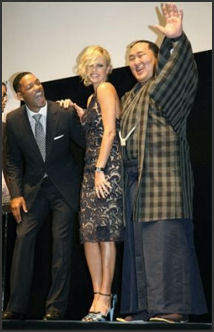
Asashoryu with Hollywood
celebrity Will Smith Asashoryu, an aggressive and skillful Mongolian wrestler, was named the 68th yokozuna on January 2003 after winning two tournaments in a row. He was the third non-Japanese to become a grand champion (Americans Akebono and Musashimaru were the other two). At the age of 22 he was one of the youngest wrestlers to achieve the rank.
In the 2000s, Asashoryu has dominated sumo like Tiger Woods has dominated golf. A major celebrity in Mongolia and Japan, he is known for his aggressive style, flexibility and tricky moves. “I try to do dynamic sumo — use speed, strength and technique,” he said. Akebono said, “He’s strong. He has speed and he’s flexible. His future is very bright.”
Asashoryu is 185 centimeters tall and weighs 152 kilograms. He turned 28 in 2008. He is a very controversial figure. Some like his success, individuality, competitiveness and his skill as a wrestler. Others like his sumo but not his character. Yet others out and out dislike him. Asashoryu means “Blue Dragon of the Morning.”
Links in this Website: SPORTS IN JAPAN (Click Sports, Recreation, Pets ) Factsanddetails.com/Japan ; SUMO RULES AND BASICS Factsanddetails.com/Japan ; SUMO HISTORY Factsanddetails.com/Japan ; SUMO SCANDALS Factsanddetails.com/Japan ; SUMO WRESTLERS AND SUMO LIFESTYLE Factsanddetails.com/Japan ; FAMOUS SUMO WRESTLERS Factsanddetails.com/Japan ; FAMOUS AMERICAN AND FOREIGN SUMO WRESTLERS Factsanddetails.com/Japan ; MONGOLIAN SUMO WRESTLERS Factsanddetails.com/Japan
Good Websites and Sources: Nihon Sumo Kyokai (Japan Sumo Association) official site sumo.or ; Sumo Fan Magazine sumofanmag.com ; Sumo Reference sumodb.sumogames.com ; Sumo Talk sumotalk.com ; Sumo Forum sumoforum.net ; Sumo Information Archives banzuke.com ; Masamirike’s Sumo Site accesscom.com/~abe/sumo ; Sumo FAQs scgroup.com/sumo ; Sumo Page http://cyranos.ch/sumo-e.htm ; Szumo. Hu, a Hungarian English language sumo site szumo.hu ; Books : “The Big Book of Sumo” by Mina Hall; “Takamiyama: The World of Sumo” by Takamiyama (Kodansha, 1973); “Sumo” by Andy Adams and Clyde Newton (Hamlyn, 1989); “Sumo Wrestling” by Bill Gutman (Capstone, 1995).
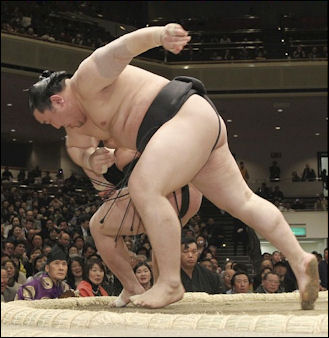
Asashoryu in the dohyo Sumo Photos, Images and Pictures Good Photos at Japan-Photo Archive japan-photo.de ; Interesting Collection of Old and Recent Photos of Wrestlers in Competition and in Everyday Life sumoforum.net ; Sumo Ukiyo-e banzuke.com/art ; Sumo Ukiyo-e Images (Japanese-language Site) sumo-nishikie.jp ; Info Sumo, a French-Language site with Good Fairly Recent Photos info-sumo.net ; Generic Stock Photos and Images fotosearch.com/photos-images/sumo ; Fan View Pictures nicolas.delerue.org ;Images from a Promotion Event karatethejapaneseway.com ; Sumo Practice phototravels.net/japan ; Wrestlers Goofing Around gol.com/users/pbw/sumo ; Traveler Pictures from a Tokyo Tournament viator.com/tours/Tokyo/Tokyo-Sumo ;
Sumo Wrestlers : Goo Sumo Page /sumo.goo.ne.jp/eng/ozumo_meikan ;Wikipedia List of Mongolian Sumo Wrestlers Wikipedia ; Wikipedia article on Asashoryu Wikipedia ; Wikipedia List of American Sumo Wrestlers Wikipedia ; Site on British sumo sumo.org.uk ; A Site About American sumo wrestlers sumoeastandwest.com
In Japan, Tickets for Events, a Sumo Museum and Sumo Shop in Tokyo Nihon Sumo Kyokai, 1-3-28 Yokozuna, Sumida-ku, Tokyo 130, Japan (81-3-2623, fax: 81-3-2623-5300) . Sumo ticketssumo.or tickets; Sumo Museum site sumo.or.jp ; JNTO article JNTO . Ryogoku Takahashi Company (4-31-15 Ryogoku, Sumida-ku, Tokyo) is a small shop that specializes is sumo wrestling souvenirs. Located near the Kokugikan national sports arena, it sells bed-and bath accessories, cushion covers, chopstick holders, key chains, golf balls, pajamas, kitchen aprons, woodblock prints, and small plastic banks — all featuring sumo wrestling scenes or likenesses of famous wrestlers.
Asashoryu’s Life
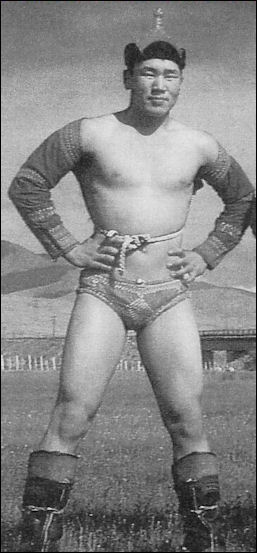
as a young Mongolian wrestling Asashoryu, whose real name is Dolgorsuren Dagvadori, was born in Ulaan Bataar, Mongolia in September 1982. He spent his childhood like most Mongolians sleeping in a ger, herding sheep and riding horses. His father and two brothers were Mongolian-style wrestlers. Asashoryu said, “When I was growing up in Mongolia conditions were very harsh and that prepared me well for sumo.” He told the Los Angeles Times, “I was the baby. We were poor; and my father was a strong figure; it was my dream to be like him. My older brother was 100 times stronger than I am. So I’ve always been very, very competitive.”
Asashoryu came to Japan in 1997. He was sent by his father, to a high school in Kochi, Japan — Meitoku Gijuku, a school famous for producing baseball players and sumo wrestlers. He learned Japanese in school and acclimated himself to the culture. When he finished school he joined a sumo stable.
Asashoryu made his professional sumo debut in December 1999 at the age of 19 and rose quickly through the ranks to the makuchi level and quickly established himself as one of the most thrilling wrestlers to watch. He was promoted to ozeki in July 2002. He was the first Mongolian and only foreigner besides the Hawaiians Akebone, Konishiki and Musashimaru to do so. Moreover, he achieved the rank faster than other wrestler in the history of the sport.
Asashoryu speaks Japanese and lives in Japan. Some say he is fluent; other have criticized him for not speaking better Japanese. Asashoryu has kept some of his Mongolian traditions. For example, he puts horsemeat on his muscle injuries. In his free time he amuses himself playing video games . At an average lunch he down three bowls of pork, tofu and rice, an omelet and plates of spaghetti.
Asashoryu was married in 2002 when he was an ozeki. He had dated his Mongolian wife — Gombotseren Tamir’since he was 16. They had two children — a boy and a girl. At his wedding party in Tokyo in 2004, more than 800 guests showed up, including diet members and star athletes form other sports. Most of the wedding party expenses were paid for by a television station which paid Asashoryu an appearance fee for showing up.
In July 2009 Asashoryu announced that he had divorced his wife earlier in the year. In his blog he said the decision was reached after he and his ex-wife “repeatedly held discussions.” His wife retained custody the children. The couple had been separated for several years with her living primarily in Mongolia while he lived in Japan.
Asashoryu’s Sumo

Asashoryu For much of career has been light for a sumo wrestler, weighing between 120 and 140 kilograms. He is able to defeat opponents many times his size with his lighting quick moves, controlled intensity, quick reflexes, quick-thinking improvisation, and an array of techniques, some of which are more common in Mongolian wrestling than sumo.
Asashoryu is an aggressive and creative wrestler who is able to respond to almost any move that his opponents throw at him. Sumo commentator Dave Wiggins wrote in the Asahi Shimbun, “Asashoryu performs with verve and panache. He is tough, quick and decisive in his movements. He has an amazing ability to instantly recognize an opening, get a grip quickly dispatch the foe — be it by force out, arm throw, leg trip of some type of combination maneuver...We talking about a ferocious elegance here.”
Describing a match against another yokozuna Hakuho, James Hardy wrote in the Daily Yomiuri: “Hakuho came in at the tachai and got his left-hand to a belt grip, but so did Asashoryu. Then a struggle of epic proportions unraveled, as each lifted the other toward the bales, both trying throw. Asashoryu gave up his outside grip in favor of an inside hold and then had the position he needed to win. It didn’t come easy however, as Hakuho attacked again — but this time Asa used Hakuho’s momentum t throw him down for the championship.”
Asashoryu was so dominant that during his reign sumo became very predictable and boring. For 21 bashos he was the only yokozuna. For training before bashos Asashoryu visited the stables of other wrestlers to take on all comers. The strategy helped him get prepared and find weaknesses in his opponents but also took its toll physically on the yokozuna.
Asashoryu’s Sumo Career

given Emperor's Cup
by Prime Minister Hatoyama
Asashoryu won his first Emperor’s Cup in November 2002 at the age of 22, becoming the first Mongolian to win a sumo championship and tying the record for accomplishing the feat in the fewest number of tournaments after becoming professional sumo wrestler.
Asashoryu won five out of six tournaments in 2004. He was the first to accomplish this since Chiyonofuji did it in 1986. Asashoryu won two straight tournament with a perfect record in January and March 2004 and won 35 bouts in a row. He won his 10th tournament in December 2005. For the year he went undefeated in two tournaments and went 13-2 in three others.
His only poor showing was a 9-6 tournament in September, attributed to too much goofing off in the summer. Around that time his neighbors called the police after he returned home to stable drunk and broke a window to try and get in. Earlier he threw a rival down by grabbing him on his top knot, becaming the first top wrestler to lose through disqualification.
In his career Asashoryu was 669-173 in 67 tournaments. He won 25 Emperor’s Cups, third on the all time list, and won five tournaments with a 15-0 record, forth on the all time list. His longest streak was 35 straight victories, the forth longest streak ever. He won his first title in his 24th tournament, tying the record for fastest ever.
Asashoryu’s Success

Asashoryu Asashoryu won all six tournaments in 2005. His victory at the Kyushu tournament in November of that year gave him seven straight tournament victories, 83 wins in 89 bouts with only six losses. He set the one year win records, beating out the one year 82-win record set by former yokozuna Kitanoumi and gave him 13 wins in 14 tournaments. Tears came down his eyes when he secured victory, his 15th overall, placing him 5th on the all time list at the age of 25, with a good chance of breaking Taiho’s record of 32 tournament victories.
Asashoryu straight run of seven victories was broken in January 2006 when Tochiazma won his 3rd Emperor’s Cup in the New Year’s basho in Tokyo. Tochiazuma went from being threatened with demotion to 14-1 champion, defeating Asashoryu on the final day.
Hakuho beat Asashoryu in March 2006 in Osaka. Both wrestlers finished the tournament with the same record, Asashoryu won his 16th Emperors when he defeated Hakuho in the playoff which occurred after Asashoryu lost to Tochiazuma and Hakuho lost to Kaio. In May 2006, Asashoryu pulled out of the tournament after only two days because of an injury.
Asashoryu won his 19th Emperor’s Cup in Fukuoka in November 2006. He went undefeated for the fifth tine, He won his 20th title in January 2007 placing him fifth on the all time list of victories. He scored his 500th career victory on the 13th day of the his 49th basho, tying an achievement of the legendary yokuzuna Taiho.
In July 2007, Asashoryu won his 21st title and the summer basho in Nagoya with a 14-1 record. The same month, the crown prince of Japan, Prince Naruhito, visited Asashoryu’s family in Harhorin, Mongolia and drank koumiss with Asashoryu’s father in the family ger (tent). The prince told the family that his daughter Princess Aiko was a big fan of Asashoryu.
In September, Asashoryu lost four straight bouts and finished 10-5.
Asashoryu’s Un-Japanese Behavior
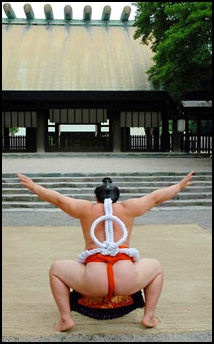
doing sumo ritual
at Shinto shrine
Asashoryu has been criticized in Japan for not acting like a true yokozuna. They say he lacks hinkaku, a sense of dignity and grace, for pumping his fist when wins, glaring at referees, and sometimes taunting his rivals an using his left hand rather than right hand to throw salt into the ring. He lost once bout against a fellow Mongolian Kyokushuzan when he yanked him down by pulling his hair — an egregious act in sumo, especially for a yokozuna — and got into an argument later with the same wrestler at a bathhouse.
The first time Asashoryu raised the eyebrows of the sumo community with his behavior was when he stared ominously at a judge and twirled his decorative tassel in disgust after losing to Kyokushuzan in May 2003. On another occasion he was criticized for failing to defer to an elder at a bathhouse.
Asashoryu also stirred up trouble with his mouth and temper. He once said, “The Japanese are no good” at sumo because “Japan’s economy developed and the people became weaker.” In the summer of 2005 police were called into break up a fight between Asashoryu and his stablemaster over the how the media money from wedding was to be divided up. Media reports on these event were sometimes colored by nationalism , calling Asashoryu names like “Genghis Khan” and the “Bully of Bator.”
There were also money and family troubles. Asashoryu failed to declare ¥100 million in income over three years until 2005, including the appearance fee for his wedding party. After the news was disclosed he paid ¥30 million to the government, including a penalty fee. Three relatives that came for the wedding were arrested and deported for overstaying their visas and getting factory jobs.
Asashoryu has also been criticized for bullying low-ranking wrestlers in his stable and injuring wrestlers from other stables during training sessions with unorthodox techniques and not nurturing young talent. One young wrestler he fought with in training was injured. A video surfaced showing Asashoryu kicking and abusing some other wrestlers in his stable during a training session.
In January 2007, Asashoryu was accused of being involved in a bout-rigging scandal by a tabloid-style magazine. See Bout Fixing, Sumo Scandals.
Asashoryu has also been criticized for skipping practices, not training hard enough, making unannounced visits to Mongolia, starring down opponents, disrespectfully twirling the decorative tassels that hang from a wrestlers belt, putting in subpar performances at regional tours and collecting of signatures for a petition for a tour of Mongolia without authorization and wearing flip-flops and an Aloha shirt in public in Hawaii and telling Japanese reporters they should die. His behavior was tolerated for years because he was the only yokozuna and the sport needed him. All that changed when Hakuho was promoted to yokozuna.
Asashoryu’s Troubles
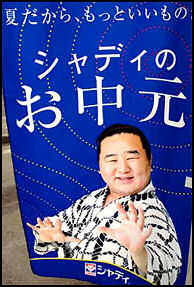
In the summer of 2007, Asashoryu was suspended for two tournaments and fined 30 percent of his salary for four months and banned from appearing in public for playing in a charity soccer match in Mongolia after skipping a sumo tour because of an alleged stress fracture in his lower back. Two days after he withdrew from tournament, had been was okayed after he submitted medical documentation for the injury, he was filmed running, kicking a soccer ball and jumping and goofing around after scoring a goal.
Asashoryu came back from Mongolia after the news broke about the soccer game and made some apologies and offered to participate in the tour but was rebuffed. Instead he was restricted from leaving his Tokyo apartment, except for hospital visits and training — effectively putting him under house arrest. The severe punishment was given because his behavior was unbecoming of a yokozuna and he mislead the sumo association about his physical condition and failed to fulfill his obligations by not going on the tour. Many saw it as a chance to give Asashoryu something he had coming for a long time.
Many were disgusted by Asashoryu’s behavior, especially when he refused to adequately apologize and express remorse. Makiko Uchidate, the female member of the Yokozuna Deliberation Council, refused to refer to him by name. Some fans thought he should be banned for life from the sport. People that bought tickets for the tour of northern Japan that he skipped out of were particularly incensed.
Asashoryu’s defenders claim people overreacted; that Asashoryu spent a great deal of time fulfilling demands made on him; and said was encouraged by the Japanese ambassador in Mongolia to participate in the soccer game, a match between Mongolian and Japanese youths in Ulan Batar. Asashoryu was asked to play in the tournament by Japanese soccer star Hidetoshi Nakata who was on the same flight as Asashoryu to Mongolia.
Asashoryu’s Psychological Troubles
Shocked by the severity of his punishment, Asashoryu fell into deep depression and was given permission to return to Mongolia after doctors confirmed the severity of his condition and diagnosed him as having a stress-related “disassociative disorder” whose symptoms include “blocking out of critical personal information, usually of a traumatic or stressful nature.”
Photos of Asashoryu show him with a depressed, glazed over expression. The doctors reportedly came to their decision because “He didn’t respond to those who met him — he only said “Ah,” or “Ugh.” The doctors said Asashoryu would likely respond well in a place he felt comfortable and calm. After weeks of deliberating on the issue, the Japanese Sumo Association allows him to leave for Mongolia.
Asashoryu left, reportedly on the edge of a nervous breakdown, and was required to live under house arrest conditions while in Mongolia. Even the Japanese Prime Minister Shinzo Abe expressed concern over his condition.

People were shocked by what a baby Asashoryu was. Yokozuna are expected to be stoic and strong no matter what adversity they face and others have suffered worse. A fellow Mongolian wrestler returned to competition within weeks after losing his father and brother in a car crash. Chiyotaikai did the same after losing his infant daughter to crib death.
Asashoryu spent three months in Mongolia. He reportedly received treatment at a spa near Karakoram, the ancient capital of Mongolia. He apologized for his inappropriate behavior after returning from Mongolia in November 2007. Asashoryu missed two bashos: the one in Tokyo in September, 2007 and the one in Kyushu in November
Asashoryu’s Comeback
Asashoryu returned to sumo at the New Year basho in January 2008. People waited in long line in bitter cold to get their hands on tickets. Asashoryu bento box lunches, with grilled lamb, were selling out just as fast. People said they hadn’t seen anything like it since the Waka-Taka era. Television ratings were also very high. Asashoryu showed up in a while Rolls Royce. When he stepped out of the car, he told reporters and photographers, “Oi! Get out of my way!”
Asashoryu won his 22nd title at the basho in Osaka in March 2008, throwing Hakuho on the final day. The victory tied him with Takanohona on the all-time list and denied Hakuho of a forth straight victory
Asashoryu competed in two bashos but withdrew before the tournaments was over because of injury. At the basho in July 2008, he dropped out with a three-three record. At the basho in September 2008, he lost four times against five win before dropping out. Asashoryu balmed his poor performance on a bad elbow that he injured in training sessions at other stables. He also missed November sumo tournament because of his elbow injury, a move that pushed perilously close to retirement, and went to Mongolia for treatment at a hot spring there.
Asashoryu’s Win After His Comeback

Asashoryu Asashoryu won the New Year Grand Sumo tournament, his 23rd Emperor’s Cup in January 2009 in thrilling fashion on the last day with a playoff victory over Hakuho after Hakuho beat him in the last regulation match of the basho just minutes before. The victory put Asashoryu alone in forth on the all time list behind Kitanoumi (24), Chiyonofuji (31) and Taiho (32).
Early in the basho Asashoryu looked a little rusty, but he survived the opening five days without a loss and picked up steam and confidence after that, one day displaying his temper. Responded to a nasty but legal slap he gave his opponent a nasty shove into the crowd after the opponent had already stepped out of bounds.
Asashoryu celebrated his basho victory by raising both arms in the air and telling the crowd, “I’m back.” . Later he was sharply criticized by the JAS for his over-exuberant behavior. JSA chairman Musashigawa said, “Doing that while in the ring is just not acceptable.” But Musashigawa was also glad that Asashoryu was back. He told the Daily Yomiuri, “The only way to describe him is amazing. His mental strength is awesome. I was a little worried about him in the first half of the tournament, but he kept his concentration and found his rhythm...In the second week in particular, his performance was classic Asashoryu.”
Asashoryu’s return brought sell out crowds not half filled areas as was the case when he was absent. There were concerns about Asashoryu’s condition coming into the tournament. He did not look good in pre-tournament practices, where he was pushed around by lesser wrestlers and lost 10 of 16 bouts. Many thought he would be lucky to emerge from the basho with a winning record, and rumors circulated about his imminent demise.
Asashoryu performed respectively but didn’t win at the May 2009 basho. After the tournament returned home to Mongolia to seek treatment for an injury to the right side of his chest. Before the basho he and Hakuho were given stiff warnings for playing golf with several other Mongolian wrestlers two days before the start of a tournament.
Asashoryu Continues Winning After His Comeback

Asashoryu In September 2009, Asashoryu defeated Hakuho in a play-off to win his 24th Emperor’s Cup. On the final day Asashoryu was undefeated and Hakuho was 13-1. After a bad taichi, Hakuho easily defeated Asashoryu in the final bout of the regulation tournament. In the playoff Asashoryu got off to a quick start and got a good left hand grip on Hakuho’s belt and brought the big man down.
Asashoryu continued to raise eyebrows with his conduct. In August 2009, Asashoryu was criticized for skipping a training session because, the wrestler said, he was worried about catching the A/H1N1 flu from other wrestlers on the bus to the session. At that time about 30 wrestlers had caught the flu. He was also hampered by injuries. In the summer of 2009, Asashoryu hurt ligaments in his knee.
In January 2010,Asashoryu won his 25th Emperor’s Cup. He sewed up the victory on the second to last day when Hakuho lost. Asashoryu lost twice, including the final day match to Hakuho, who finished 12-3. The victory turned out to Asashortyu’s last. Twenty-five victories was no give him sole possession third on the list of all time victories behind Taiho (32) and Chiyonofuji (31). Asked about wjat made him successful he said, “A string heart and support of the fans, Hopefully I can keep going.”
By this time Asashoryu was appearing in television commercials for Fanta. Once when he was asked about his plans after retirement, Asashoryu said, “I am going ti become president of Mongolia.
Asashoryu Punches Out a Guy and Retires
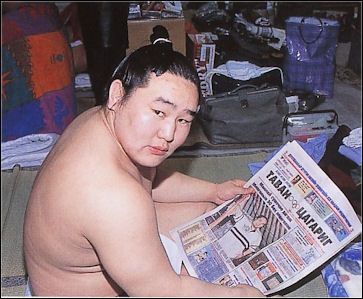
Asashoryu In January 2010, during the middle of a tournament that he won, Asashoryu got into a drunken incident with a man at a night club in Tokyo’s Nishiazabu District. The sumo wrestler initially said he was “wrecked” and punched an acquaintance, thought by some to have been his manager, but later the weekly tabloids “ Friday “ and “Shukan Shincho“ reported that victim, the manager at a dance club where Asashoryu was partying, sustained a broken nose, lacerated lip, bruises on the back of his head and other injuries.
According to “Shukan Shincho” Asashoryu punched the victim the chest while excited at the club and later hit him in the face after the yokozuna said, “Let’s go talk in the car.” The article describes Asashoryu instructing his driver ro go to a river after the man said the matter of the assault was “water under the bridge.” As the car drove off, the yokozuna reportedly said, “I’ll kill you there.” The victim then drove past some police, who were at the scene of an accident, shouting “help...I’m being attacked.”
Asashoryu’s stablemaster said, “It seems Asashoryu was drunk and doesn’t remember anything.” A few days after that Asashoryu and the man came to agreement through Asashoryu’s lawyer and the victim promised not to file a report with police. For a while it seemed like the whole episode might blow over. But it didn’t.
In February 2010, Asashoryu announced his retirement from sumo. In the press conference he said, “I caused trouble to a lot of people and I feel hugely responsible as a yokozuna. I was the only one who could finish this matter the right way...I think I was destined to end my career this way.”
The announcement followed a Japan Sumo Association meeting that Asashoryu had been summoned to. At meeting it seems he was given the choice of resigning or being the first yokozuna to be fired. After a short meeting with his stablemaster Asashoryu said he would retire. In an interview with NHK he said he loved sumo more than anything and wanted to continue a try to break the all-time tournament victory record. When asked how he felt about Asashoryu’s retirement, fellow yokozuna Hakuho broke into tears and aid Asashoryu inspired him.
It was the first time that a yokozuna had ever been forced to retire. The Yokozuna Deliberation Council voted unanimously, with one member absent, that it was time for Asashoryu to go. Asashoryu received a retirement payout of about $1.3 million. The figure is normally based on performance in the ring. In addition to this he received a pension and an additional bonus based on his service in the JSA.
At a press conference held more than a month after his retirement Asashoryu denied being involved in a drunken rampage, “I didn’t commit any violent acts.” One rumor he might go into mixed martial arts, he said, “I haven’t really thought about what to do next. I don’t regret my decision to quit sumo.” Asashoryu submitted to voluntary police questioning in May 2010 over the drunken rampage that led to his retirement.. He told police his “hand may have hit the man” while they sat together in a car. Police said they decided to carry out an investigation because the incident had such a broad social impact. Asashoryu’s assault case was referred to prosecutors in July 2010.
Asashoryu formally retired in October 2010 when his topknot was removed in ceremony attended by many Japanese celebrities and sumo’s top wrestlers, Afterwards he said, “In another life as a Japanese, I would like to become a yokozuna with Japanese spirit. I will move on to my next dream in life. I want to show everyone that I can become a better person.” Because Asashoryu is not a Japanese citizen he is not allowed to continue in sumo after he retires.
Two Men Accused of Defrauding Asashoryu
In November 2011, Kyodo reported: “Two men were arrested on suspicion of defrauding former yokozuna Asashoryu of about 100 million yen ($1.28 million), telling the sumo superstar that his money would be used to help people in Mongolia, police said. [Source: Kyodo, November 30, 2011]
Company executives Takeo Kikuchi, 77, and Takaharu Kumada, 63, asked Asashoryu for a loan to cover an overdue storage fee for gold bricks kept in the Philippines in April 2009, police said. They told the Mongolian that the gold would be converted into cash, 1 trillion yen of which would be used for Mongolia, according to police.
Asashoryu transferred about 100 million yen to Kumada's bank account, they said. The former yokozuna contacted police in March this year after the money was not returned to him. Asashoryu, whose real name is Dolgorsurengiin Dagvadorj, met the two suspects through a Japanese female acquaintance in February 2009.
Image Sources: 1) Sumo Forum, 2) Japan-Photo.de 3) University of Washingon
Text Sources: New York Times, Washington Post, Los Angeles Times, Daily Yomiuri, Times of London, Japan National Tourist Organization (JNTO), National Geographic, The New Yorker, Time, Newsweek, Reuters, AP, Lonely Planet Guides, Compton’s Encyclopedia and various books and other publications.
Last updated January 2013
